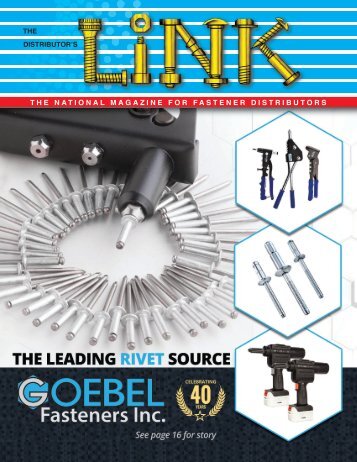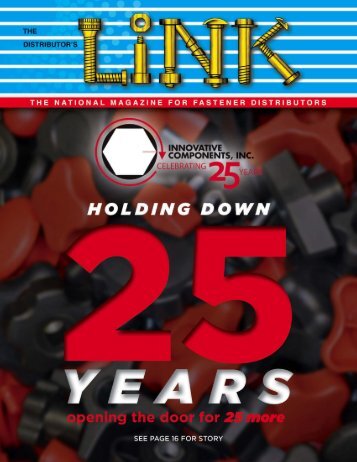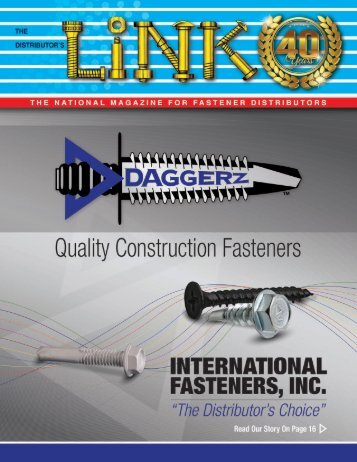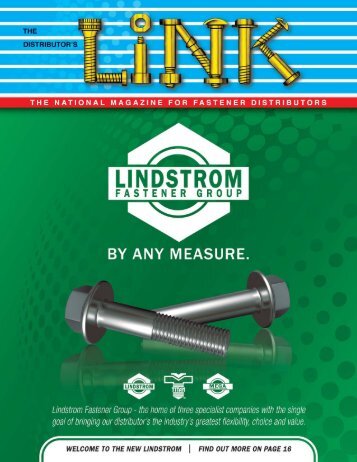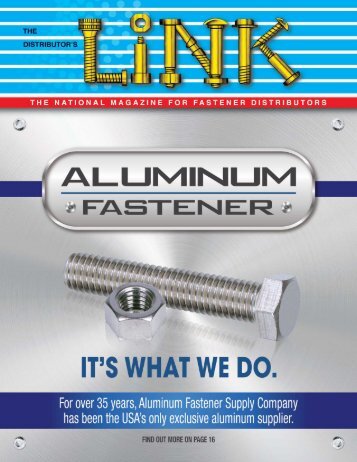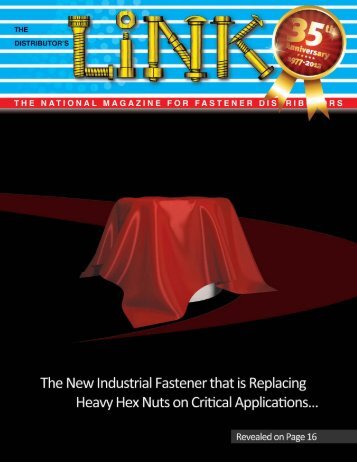SUMMER 2018
- Text
- Fastener
- Fasteners
- Products
- Diameter
- Pins
- Distributors
- Manufacturing
- Industrial
- Rivet
- Screws
156 THE DISTRIBUTOR’S
156 THE DISTRIBUTOR’S LINK ANTHONY Di MAIO USING THE CORRECT SIZE BLIND RIVET from page 76 Using the correct length closed-end blind rivet the upset side will look like this: UPSET SIDE FIGURE 4 - PROPERLY SET RIVET When the blind rivet is too short: FIGURE 5 - BARREL LENGTH TOO SHORT When the blind rivet length is too long: LONG UPSET FIGURE 6 Hole diameter is also very important. I receive calls telling me that the mandrel head is setting deep in the rivet body. This is caused by the diameter of the hole in the work piece is too large. But users tells me that they need to have oversize holes in order to line up the holes in the two work pieces that they are riveting together. If it is necessary to have oversize holes for the hole line up, they should make the hole larger in the work piece that is on the flange side of the blind rivet and the correct diameter hole size on the upset side of the blind rivet. Having the correct hole size on the upset side, the mandrel head will be in the correct position after setting the blind rivet. In this application a large flange blind rivet should be used. The large flange of the blind rivet will cover the oversized hole and will give the user a tight riveted joint. If it is necessary to have an elongated hole in the work piece to line -up the rivet upset hole in the work piece, a large flange blind rivet will cover the elongated hole and will again give the user a tight riveted joint. The blind rivet is a mechanical device that can join component parts in an assembly where access for the fastener installation and activation is available from only one side. Specifically a blind rivet is a blind fastener having a self-contained mechanical feature, which permits formation of an upset on the blind side of the work pieces. The expansion of the blind rivet body during rivet setting joins work pieces to form an assembly. This expansion is created by the head of the mandrel being pulled into the blind rivet body by the rivet setting tool. The mandrel has a break point just below the mandrel head. This is where the mandrel will break when the setting tool is pulling the mandrel with a force greater than the tensile strength of the mandrel break point. When the mandrel breaks at the break point, the blind rivet is properly set and gives the riveted point the tensile and shear values listed in the (IFI) Industrial Fasters Institute specification No. 114 or the tensile and shear values that the blind rivet manufacturer lists in their catalog. The setting speed of the blind rivet has been the major user consideration for using blind rivets. A blind rivet properly used, regarding rivet length, diameter of the blind rivet holes and thickness of the work., it is the quickest way to fasten together an assembly. I have been asked many times “The blind rivet setting tool is cutting the mandrel too soon and the blind rivet is not set. The blind rivet setting tool is not cutting the mandrel. The mandrel breaks at the breaking point, but the tensile strength of the mandrel breaking point is too low. The user should contact the blind rivet manufacturer informing them of the condition. The setting speed of a blind rivet is fast and effective and has been the major user consideration for using blind rivets. When using the correct size blind rivet, regarding length, diameter of the rivet holes and proper work thickness, you are using the fastest method to fasten an assembly together. ANTHONY Di MAIO
FASTENER FAIR USA CLEVELAND, OH - APRIL 11-12, 2018
- Page 6 and 7:
in thesummer 2018 issue of 6 DISTRI
- Page 8:
6 THE DISTRIBUTOR’S LINK Goebel F
- Page 12:
10 THE DISTRIBUTOR’S LINK Guy Ave
- Page 16:
14 THE DISTRIBUTOR’S LINK Robert
- Page 28:
26 THE DISTRIBUTOR’S LINK Jim Tru
- Page 32:
30 THE DISTRIBUTOR’S LINK Carmen
- Page 37 and 38:
THE DISTRIBUTOR’S LINK 35
- Page 40 and 41:
38 THE DISTRIBUTOR’S LINK Jim Rue
- Page 42:
40 THE DISTRIBUTOR’S LINK INDUSTR
- Page 45 and 46:
THE DISTRIBUTOR’S LINK 43
- Page 47 and 48:
THE DISTRIBUTOR’S LINK 45 Advance
- Page 50:
48 THE DISTRIBUTOR’S LINK ARNOLD
- Page 53 and 54:
INTERNATIONAL FASTENERS, INC. Tampa
- Page 55 and 56:
American Ring, a family owned and o
- Page 57 and 58:
THE DISTRIBUTOR’S LINK 55
- Page 60 and 61:
58 THE DISTRIBUTOR’S LINK GLOBALF
- Page 62 and 63:
60 THE DISTRIBUTOR’S LINK SPIROL
- Page 64:
62 THE DISTRIBUTOR’S LINK ASPHALT
- Page 68:
66 THE DISTRIBUTOR’S LINK UNIVERS
- Page 72 and 73:
70 THE DISTRIBUTOR’S LINK GLOBALF
- Page 74:
FASTENER FAIR USA WELCOME PARTY, RO
- Page 77 and 78:
THE DISTRIBUTOR’S LINK 75
- Page 79 and 80:
THE DISTRIBUTOR’S LINK 77 UNICORP
- Page 82 and 83:
80 THE DISTRIBUTOR’S LINK Roman B
- Page 84 and 85:
82 THE DISTRIBUTOR’S LINK NATIONA
- Page 86 and 87:
84 THE DISTRIBUTOR’S LINK The New
- Page 88 and 89:
86 THE DISTRIBUTOR’S LINK Bryce A
- Page 90 and 91:
88 THE DISTRIBUTOR’S LINK The Met
- Page 92:
90 THE DISTRIBUTOR’S LINK Larry B
- Page 95 and 96:
NCFA 10th ANNUAL DISTRIBUTOR SOCIAL
- Page 98 and 99:
96 THE DISTRIBUTOR’S LINK GUY AVE
- Page 100 and 101:
98 THE DISTRIBUTOR’S LINK JOE DYS
- Page 102 and 103:
100 THE DISTRIBUTOR’S LINK ROBERT
- Page 104 and 105:
102 THE DISTRIBUTOR’S LINK LAUREN
- Page 106 and 107: 104 THE DISTRIBUTOR’S LINK SOUTHE
- Page 108: 106 THE DISTRIBUTOR’S LINK MSC IN
- Page 111 and 112: THE DISTRIBUTOR’S LINK 109
- Page 113 and 114: FASTENER FAIR USA CLEVELAND, OH - A
- Page 115 and 116: Lindstrom LLC, a master distributor
- Page 118 and 119: 116 THE DISTRIBUTOR’S LINK JIM RU
- Page 120 and 121: 118 THE DISTRIBUTOR’S LINK IFI 20
- Page 122 and 123: 120 THE DISTRIBUTOR’S LINK FASTEN
- Page 124: 122 THE DISTRIBUTOR’S LINK ARNOLD
- Page 127 and 128: Suncor Stainless is looking towards
- Page 129 and 130: fastenerlinks BRINGING YOU THE FAST
- Page 131 and 132: fastenerlinks BRINGING YOU THE FAST
- Page 133: THE DISTRIBUTOR’S LINK 131 Endrie
- Page 136: 134 THE DISTRIBUTOR’S LINK STAFDA
- Page 140 and 141: 138 THE DISTRIBUTOR’S LINK PACIFI
- Page 142 and 143: 140 THE DISTRIBUTOR’S LINK UNICHE
- Page 144 and 145: 142 THE DISTRIBUTOR’S LINK GLOBAL
- Page 146: 144 THE DISTRIBUTOR’S LINK SPIROL
- Page 149 and 150: FASTENER FAIR USA CLEVELAND, OH - A
- Page 151 and 152: SFA SPING CONFERENCE & GOLF OUTING
- Page 153 and 154: THE DISTRIBUTOR’S LINK 151
- Page 156: 154 THE DISTRIBUTOR’S LINK BENGT
- Page 161 and 162: THE DISTRIBUTOR’S LINK 159 Distri
- Page 163 and 164: THE DISTRIBUTOR’S LINK 161
- Page 165 and 166: THE DISTRIBUTOR’S LINK 163 MAFDA
- Page 167 and 168: THE DISTRIBUTOR’S LINK 165 PUZZLE
- Page 170 and 171: 168 THE DISTRIBUTOR’S LINK CARMEN
- Page 172 and 173: 170 THE DISTRIBUTOR’S LINK COMPUT
- Page 174 and 175: 172 THE DISTRIBUTOR’S LINK MICHAE
- Page 176 and 177: 174 THE DISTRIBUTOR’S LINK SPIROL
- Page 178 and 179: 176 THE DISTRIBUTOR’S LINK LARRY
- Page 180 and 181: 178 THE DISTRIBUTOR’S LINK LAUREN
- Page 182 and 183: 180 THE DISTRIBUTOR’S LINK SEFA S
- Page 184: 182 THE DISTRIBUTOR’S LINK MICHAE
- Page 188 and 189: 186 THE DISTRIBUTOR’S LINK MICHAE
- Page 190 and 191: NFDA 50th ANNIVERSARY MEETING & CEL
- Page 192 and 193: PAC-WEST 50TH ANNIVERSARY MEETING &
- Page 194: PAC-WEST 50TH ANNIVERSARY MEETING &
- Page 198: advertisers index D DELTA SECONDARY
- Page 202: advertisers index R RAF ELECTRONIC
Inappropriate
Loading...
Mail this publication
Loading...
Embed
Loading...
|
SHARE A PAGE FROM THIS MAGAZINE OPTION 1: Click on the share tab above, or OPTION 2: Click on the icon (far right of toolbar) and then click on the icon (far right of toolbar) and then click on the  icon (top right of the page). icon (top right of the page).
|
View Archives
Copyright © Distributor's Link, Inc. All Rights Reserved | Privacy Policy

























